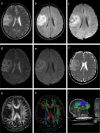Advanced Diagnosis of Glioma by Using Emerging Magnetic Resonance Sequences
- PMID: 34422648
- PMCID: PMC8374052
- DOI: 10.3389/fonc.2021.694498
Advanced Diagnosis of Glioma by Using Emerging Magnetic Resonance Sequences
Abstract
Glioma, the most common primary brain tumor in adults, can be difficult to discern radiologically from other brain lesions, which affects surgical planning and follow-up treatment. Recent advances in MRI demonstrate that preoperative diagnosis of glioma has stepped into molecular and algorithm-assisted levels. Specifically, the histology-based glioma classification is composed of multiple different molecular subtypes with distinct behavior, prognosis, and response to therapy, and now each aspect can be assessed by corresponding emerging MR sequences like amide proton transfer-weighted MRI, inflow-based vascular-space-occupancy MRI, and radiomics algorithm. As a result of this novel progress, the clinical practice of glioma has been updated. Accurate diagnosis of glioma at the molecular level can be achieved ahead of the operation to formulate a thorough plan including surgery radical level, shortened length of stay, flexible follow-up plan, timely therapy response feedback, and eventually benefit patients individually.
Keywords: 7-T magnetic resonance imaging; differential diagnosis; glioma; magnetic resonance image; preoperative grading; radiomics; response assessment in neuro-oncology (RANO).
Copyright © 2021 Wei and Wei.
Conflict of interest statement
The authors declare that the research was conducted in the absence of any commercial or financial relationships that could be construed as a potential conflict of interest.
Figures


Similar articles
-
Radiomics Nomogram Building From Multiparametric MRI to Predict Grade in Patients With Glioma: A Cohort Study.J Magn Reson Imaging. 2019 Mar;49(3):825-833. doi: 10.1002/jmri.26265. Epub 2018 Sep 8. J Magn Reson Imaging. 2019. PMID: 30260592
-
Early response assessment of glioma patients to definitive chemoradiotherapy using chemical exchange saturation transfer imaging at 7 T.J Magn Reson Imaging. 2019 Oct;50(4):1268-1277. doi: 10.1002/jmri.26702. Epub 2019 Mar 12. J Magn Reson Imaging. 2019. PMID: 30864193
-
Comparison of Radiomics Analyses Based on Different Magnetic Resonance Imaging Sequences in Grading and Molecular Genomic Typing of Glioma.J Comput Assist Tomogr. 2021 Jan-Feb 01;45(1):110-120. doi: 10.1097/RCT.0000000000001114. J Comput Assist Tomogr. 2021. PMID: 33475317
-
Updated response assessment criteria for high-grade glioma: beyond the MacDonald criteria.Chin Clin Oncol. 2017 Aug;6(4):37. doi: 10.21037/cco.2017.06.26. Chin Clin Oncol. 2017. PMID: 28841799 Review.
-
State-of-the-art imaging for glioma surgery.Neurosurg Rev. 2021 Jun;44(3):1331-1343. doi: 10.1007/s10143-020-01337-9. Epub 2020 Jun 30. Neurosurg Rev. 2021. PMID: 32607869 Free PMC article. Review.
Cited by
-
Neuroimaging at 7 Tesla: a pictorial narrative review.Quant Imaging Med Surg. 2022 Jun;12(6):3406-3435. doi: 10.21037/qims-21-969. Quant Imaging Med Surg. 2022. PMID: 35655840 Free PMC article. Review.
-
Exploring the association of glioma tumor residuals from incongruent [18F]FET PET/MR imaging with tumor proliferation using a multiparametric MRI radiomics nomogram.Eur J Nucl Med Mol Imaging. 2024 Feb;51(3):779-796. doi: 10.1007/s00259-023-06468-x. Epub 2023 Oct 21. Eur J Nucl Med Mol Imaging. 2024. PMID: 37864593
-
Freiburg Neuropathology Case Conference : A 51-year-old Patient Presenting with Transient Speech Disorder and a Mass Lesion in the Right Parietal White Matter.Clin Neuroradiol. 2022 Sep;32(3):875-881. doi: 10.1007/s00062-022-01195-6. Epub 2022 Jul 26. Clin Neuroradiol. 2022. PMID: 35881163 Free PMC article. No abstract available.
-
Detection of TERT Promoter Mutations as a Prognostic Biomarker in Gliomas: Methodology, Prospects, and Advances.Biomedicines. 2022 Mar 21;10(3):728. doi: 10.3390/biomedicines10030728. Biomedicines. 2022. PMID: 35327529 Free PMC article. Review.
-
A Systematic Review of the Current Status and Quality of Radiomics for Glioma Differential Diagnosis.Cancers (Basel). 2022 May 31;14(11):2731. doi: 10.3390/cancers14112731. Cancers (Basel). 2022. PMID: 35681711 Free PMC article. Review.
References
Publication types
LinkOut - more resources
Full Text Sources
Research Materials

